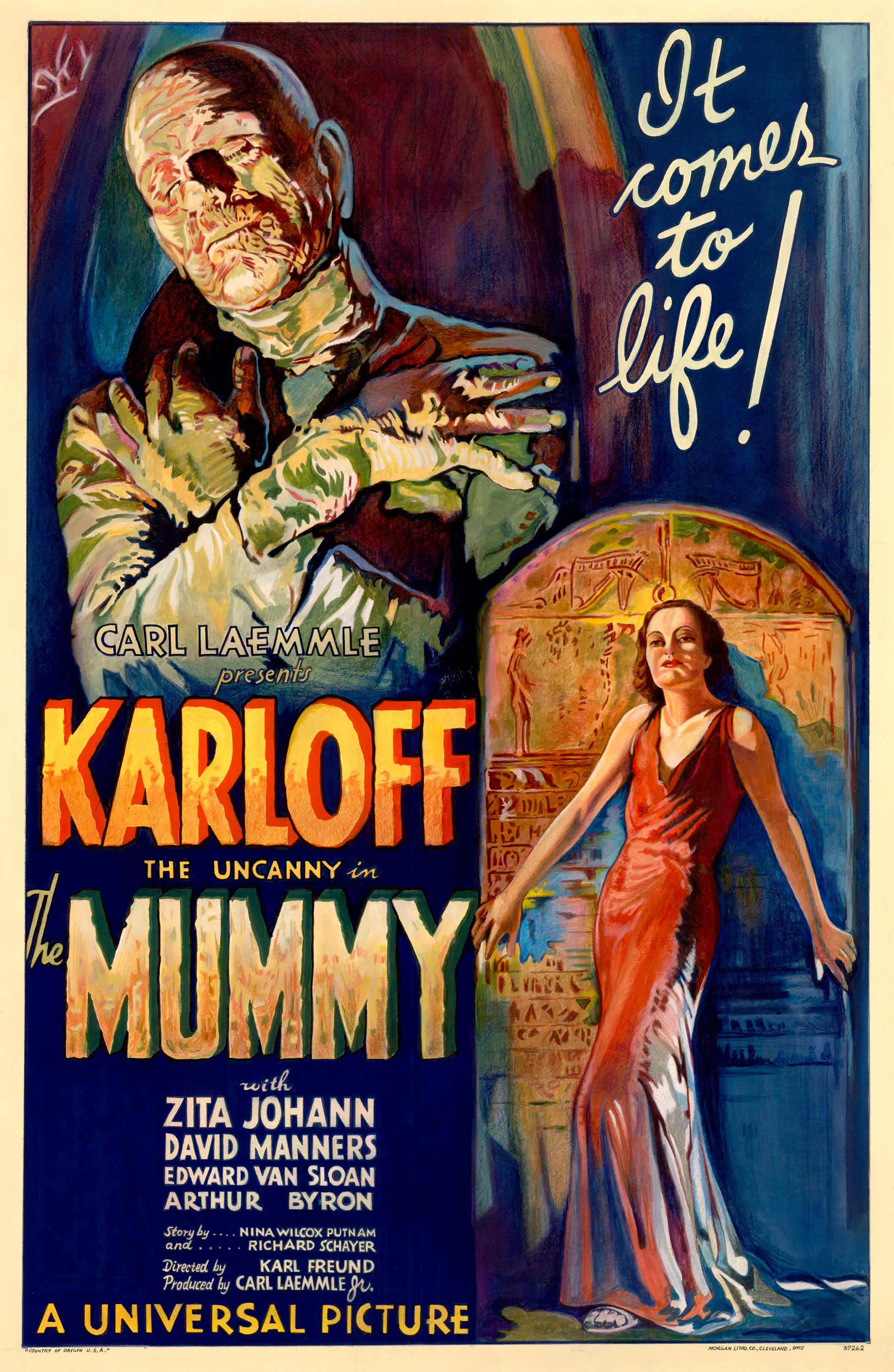The discovery of Pharoah Tutankhamun's tomb in 1922 inspired a wave of "Egyptomania", where anything connected to the Land of the Pharaohs was in vogue. Ten years later, the very first film version of The Mummy was released. Atmospheric and effective with a standout central performance, The Mummy is not scary but well-crafted.
A British Museum expedition to Egypt in 1921 has uncovered a previously unknown tomb. Archeologist Sir Joseph Whemple (Arthur Byron) is thrilled with the discovery. Here, Whemple finds the mummified remains of Imhotep, an Egyptian priest who was buried alive. Alive again Imhotep becomes when a young archeology photographer opens a seal casket, reading the ancient Scroll of Thoth. The Mummy now walks free.
Now in 1932, Sir Joseph's son Frank (David Manners) follows in his father's footsteps. He is about to close out this season when a mysterious Egyptian figure calling himself Ardath Bey (Boris Karloff) guides him to another previously unknown tomb. This is the tomb of the Princess Ankh-es-an-Amon, which thrills Frank and is important enough to bring Sir Joseph back to Egypt after the latter swore off the land of Pharaohs after the 1921 expedition. The Whemple family friend, renowned occult expert Dr. Muller (Edward Van Sloan) is in Egypt too. He is the informal chaperone to Helen Grosvenor (Zita Johann), the half-Egyptian daughter of the British governor of the Sudan.
Helen soon falls into unexplained trances, leading her to the Cairo Museum where Ankh-es-an-Amon's treasures are located. She and Frank find themselves soon attracted to each other. She also bears a striking similarity to the Egyptian princess. What power does the mysterious Ardath Bey have? Could the dead really walk among the living? Will Helen find herself the Mummy's bride?
Looking at it now, almost a century after its release, The Mummy is by no means scary. It, however, builds up the mood and atmosphere, giving The Mummy an appropriately spooky sense. Karl Freund, best known as one of the premiere cinematographers of his time, takes on directing responsibilities in The Mummy.
In terms of the overall look and feel of The Mummy, Freund did wonders. In the opening sequence, we get Imhotep's slow awakening in an effective and chilling manner. The mummy slowly opens his eyes, then moves, again slowly, building up the tension. We do not see the mummy himself, but just the wrapped hand come upon the table. Bramwell Fletcher as the unfortunate expedition photographer Ralph Norton only reacts to what he sees as a terrifying figure. The fact that we do not see the mummy himself, coupled with Fletcher's crazed laughter, gives us the suggestion of something utterly frightening.
It is, as a side note, curious that while the popular image of The Mummy as this heavily wrapped figure shuffling along is engrained in pop culture, we get very little to no actual images in The Mummy to match that image. There is the opening scene of Karloff as Imhotep resurrected. However, we see only a bit of the mummy himself in The Mummy.
In most of The Mummy we get the character of Ardath Bey, this eerie, slightly withered figure. While Boris Karloff will always be best remembered as the Monster in Frankenstein, he does an absolutely excellent job as Bey/The Mummy. He is courtly and calm, frighteningly so, making the viewer feel slightly unnerved. Karloff has great eyes which The Mummy enhances with excellent camerawork, suggesting the sinister evil going on behind them.
Boris Karloff, billed as "Karloff the Uncanny", gives it his all in The Mummy and delivers an exceptional performance. It is the rest of the cast that lets him down. Zita Johann is pretty as Helen, the lost princess returned. However, I found her rather exaggerated in the film, and a bit stiff. Manners was breezy, charming and also pretty as Frank, the young man who aims to protect his lady love. However, there was not much for him to do in my view.
Van Sloan brings gravitas to Muller, the man forever warning and fighting against the forces of darkness. While Byron did well enough as Sir Joseph, his final scene seemed exaggerated, almost funny.
The acting may have been overall a bit stiff to overwrought from the cast save Karloff. However, I will grant that part of it may be due to this being Karl Freund's first time directing a film versus just photographing one. I think his past experience as a cinematographer gave him a leg up in how The Mummy looks. Freund is the man who shot Metropolis and Dracula, the latter another Universal Film with a malevolent monster attempting to have a woman as his dark queen of the dead.
The Mummy looks impressive. The sets were well-crafted, blending ancient Egypt with the current setting. The overall look and feel of The Mummy showed great skill in giving the viewer an eerie world. In that, Karl Freund did brilliant work. In terms of the acting, only Boris Karloff came away looking like he knew what he was doing.
The Mummy is atmospheric, well shot, and with an excellent performance from Boris Karloff. It may not frighten people now, but I think contemporary audiences would have been at least caught up in most of the menace that rose from the Valley of the Kings. The Mummy comes alive and does so quite well.



No comments:
Post a Comment
Views are always welcome, but I would ask that no vulgarity be used. Any posts that contain foul language or are bigoted in any way will not be posted.
Thank you.